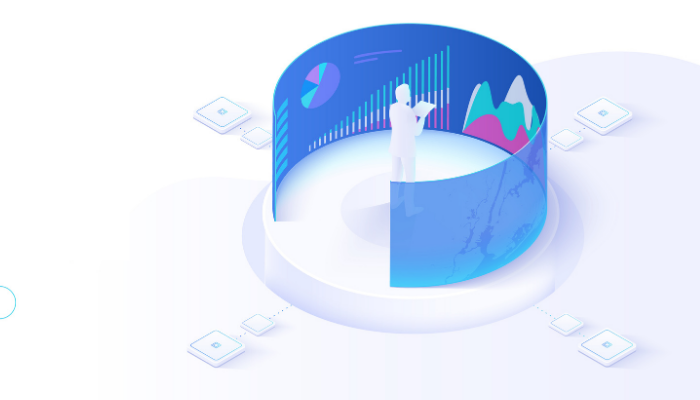If outcome-backed HR is the new buzz, people analytics is the backbone supporting the effort of such purposeful HR operations. People analytics holds the key to showing in black and white how past decisions have impacted an organization and point leaders toward the right decisions for the future. In the delicate climate that businesses are currently attempting to steer through, the data-driven approach offered by people analytics is the anchor.
People analytics is a game of numbers
The winning feature of people analytics is that HR personnel do not log the people-centered metrics manually, but let a HR analytics software take over in the form of a data center. Data needs of organizations differ widely, depending on the organizational size and their data storage needs. These numbers also drive the number of staff needed to collect and maintain people analytics data.
Outsourced data storage makes more sense for small and mid-sized companies. Large organizations with extensive workforce analytics requirements, staffing and data maintenance needs are better off having onsite data warehousing. The HR operations staff log their data as a matter of routine. The increased productivity resulting from the HR analytics package elicit performance. It takes away any wastage of resources such that it allows the personnel to make time for strategizing and workforce planning. This freed up time helps them devote more energies to gleaning insights and using them to put better policies in place.
You might also be interested to read: Analytics Jobs In India Looks Better Than Just Bright
The professional and skills at play
People analytics is more than number crunching. It is about gaining workable insights that anyone in the top management can use to refine outcomes and move towards better revenue models. The C-suite looks to leverage the story told by the numbers. They will want to further the business interests of their organization at a lower cost and toward greater effectiveness.
This translates to investing in people analytics jobs. The job profile includes bringing quantitative analysis and evaluation of every functional area, job family, down to every activity performed to achieve organizational goals. Thereupon, the analyst goes on to make reports and recommend courses of action for refining processes, right-sizing departments, and introducing policies. Examples of initiatives taken by the functionaries of analytics jobs can be attrition handling measures, tweaking of talent acquisition measures like outreach and interview style, or even specialized compensation models.
People analytics processes and goals
Often, outsiders to business think of people analytics as an outcome. It is not an end-goal. Rather, it is a process that drives outcomes. With the data warehousing and data collection practices in place, the process is about getting started on a data-driven culture and making the most of every bit of information that comes out of the analytics tools.
Gathering numerical and non-numerical data about how the human resources of an organization cope with their roles (professional performance), position in the life stage (demographic data), and any other relevant factors is the starting point for workforce analytics.
With a smattering of data, the best analytics models should be able to help the organization attract the most cost-effective, high-performing, and competent human resources. This is the ultimate goal of all people analytics strategies.
The data-driven approach is at the crux of people analytics. Clusters of data are analyzed and used to achieve workable insights. When these insights are deployed to fill job roles in an organization with the most suitable, well-matched professionals, it is called talent analytics.
Talent analytics is a crucial function of HR operations. Not only is it the core of the staffing function in HR, but it also determines the future direction that an entire business will take.
Mileage for analytics beyond hiring
With a greater repository of data, people analytics tools are able to streamline the entire employee life cycle – from the moment a professional is selected, inducted, and onboarded to further in. People analytics tools also concern themselves with performance management data, productivity and effectiveness metrics, feedback and growth (lateral or vertical) within the organization, and more – all the way up to separation. These insights help a discerning organization make crucial decisions with regard to People Capability Maturity Models (PCMM) and succession planning, among other things.
The data-driven HR policies formulated and rebooted as needed are a go-to guideline for the greater goal of HR transformation. This is the kind of information that becomes crucial when unexpected events such as the ongoing pandemic and consequent business fall-outs occur.
The simple truth is that data is valuable. Data-driven decisions stand in for traditional business wisdom and go above and beyond in being instructive. The mileage and usefulness of data don’t end with making the optimum hiring decision. It governs future people-led policies, guidelines for unforeseen events, and contingency planning.
Analytics adoption
A good starting point for the adoption of people analytics in the workplace is an evaluation of the cost centers. Revenue metrics never lie. The people analysts should have the revenue and reputation KPIs mapped out to their daily activities.
Next is the collusion of all the stakeholders so that everyone works towards the same goals. This is possible when the leaders establish and document a vision and time-bound goals. To get the initiative off the ground, a task force should come together to choose analytics software packages, determine storage needs, and appoint data-led milestones. This way, the entire approach stays true to data. A data-driven culture is focused on processes and outcomes.
Long-term direction to business lent by people analytics
People analytics starts with an HR perspective. It certainly has to be driven by the human resource department. But the long-term vision for people analytics goes beyond hiring practices, retention, or revenue models alone.
People analytics jobs often have (and ought to have) a company-wide impact. Depending on the insights and takeaways from HR analytics, workforce analytics, staffing analytics, and talent acquisition analytics, a large amount of data comes under the purview of the HR department. This should circle back to departmental heads and line managers who are at the frontline of achieving the business ends of the concern.
Done correctly, this can translate into fine-tuning of operations, integrating feedback from selection interviews and exit interviews, all the way to internal communication, rewards and recognition programs, and employee engagement practices.
It is a constant, ongoing process that helps organizations pitch higher goals forward and achieve them in an intentional, forward-looking manner. The idea of continuous improvement with a complete feedback loop is achieved via people analytics since people are the most thoughtful and eloquent resource of the organization.
References:
- People Analytics: 6 Best Practices for Successful Adoption | Digital HR Tech | Neelie Verlinden and Lexy Martin | January 2021
- What Is People Analytics? Definition, Process, Trends, and Tools | HR Technologist | Prarthana Ghosh | October 2019
You might also be interested to read:
Related Topics:




